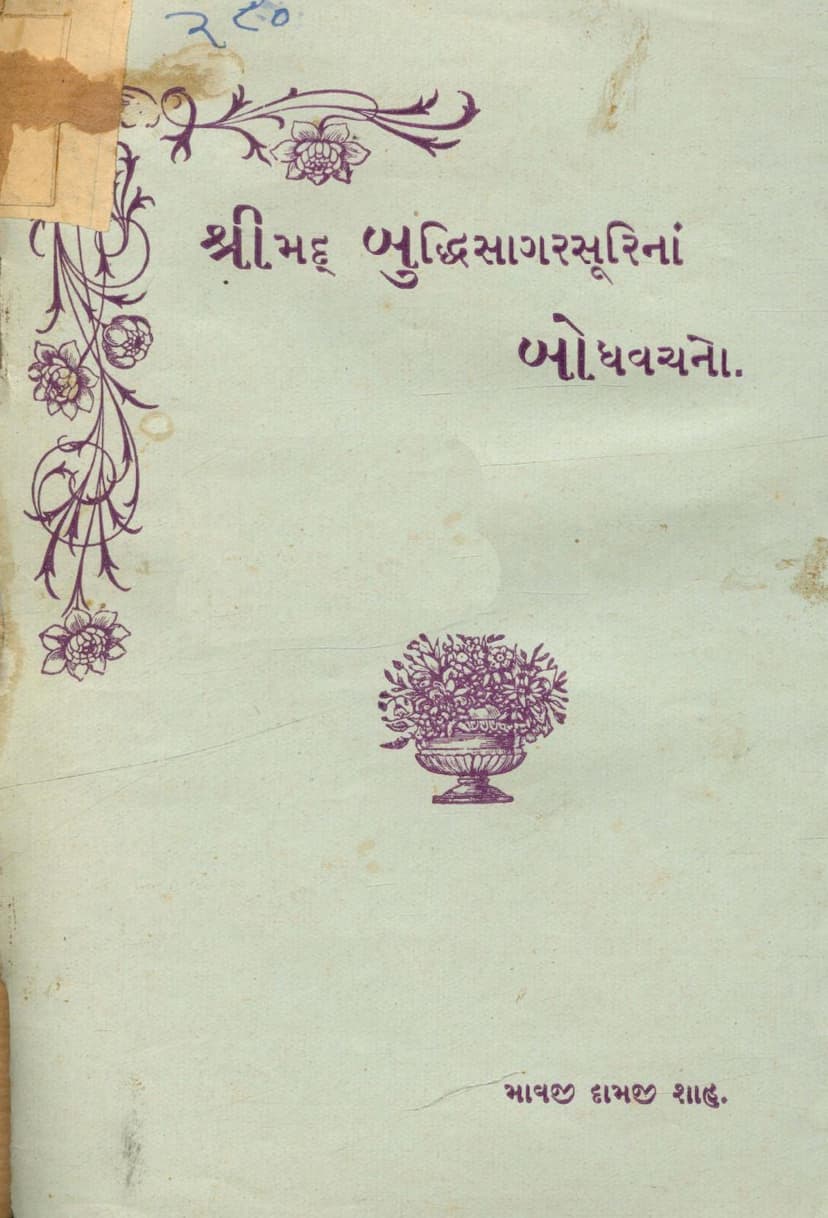Shrimad Buddhisagarsurina Bodhvachano
Added to library: September 2, 2025

Summary
Here is a comprehensive summary of the Jain text "Shrimad Buddhisagarsurina Bodhvachano" by Mavji Damji Shah:
Book Title: Shrimad Buddhisagarsurina Bodhvachano (The Teachings/Words of Wisdom of Shrimad Buddhisagarsuri) Author/Compiler/Publisher: Mavji Damji Shah Context: This book is a compilation of 108 selected "bodh vachanas" (words of wisdom) from the works of Shrimad Buddhisagarsuri. The collection was compiled and published by Mavji Damji Shah, who was a Chief Religious Teacher at Babu Panalal Puran Chand Jain High School in Mumbai. The book was published in Vikram Samvat 1995 (2465 Jain Era), which corresponds to 1939 CE. The preface states it is the first edition and was released on the occasion of the 14th birth anniversary of Shrimad Buddhisagarsuri.
Overall Theme: The book presents a collection of practical and spiritual advice from Shrimad Buddhisagarsuri, covering a wide range of topics relevant to spiritual progress and ethical living within the Jain tradition. The teachings emphasize self-improvement, devotion, righteous conduct, and understanding the core tenets of Jainism.
Key Themes and Content Breakdown:
-
The Significance of Shrimad Buddhisagarsuri: The preface highlights Shrimad Buddhisagarsuri as a prominent literary figure who served Gujarati literature with over a hundred books on various subjects. He is recognized as a "Standard Author" due to the comprehensive nature of his literary output, encompassing poetry, thought, and writing.
-
Purpose of the Compilation: The 108 selected teachings are presented without any alterations, directly from Shrimad Buddhisagarsuri's own language, to contribute to the welfare of the public.
-
Tribute and Celebration: Page 4 and 5 contain a song sung at the 14th birth anniversary of Shrimad Buddhisagarsuri, praising his life, contributions, and spiritual guidance. It mentions his birth during Shivaratri in the year 1930 (likely referring to a specific Jain calendar or event reference) and how he fulfilled his life by embracing Jainism. It also acknowledges his family background (Patidar) and his impactful work in educating both the illiterate and educated, spreading devotion through his hymns, and teaching spiritual knowledge.
-
Core Teachings (Bodh Vachanas): The majority of the book consists of question-and-answer style teachings covering various aspects of Jain philosophy and practice. Some key areas and specific teachings include:
- Tirth Yatra (Pilgrimage): The benefits of pilgrimage are discussed, including forgetting worldly worries, physical health, mental clarity, remembrance of great souls, gaining wisdom from interactions, and achieving inner purity through proper observance.
- Righteous Conduct and Wealth: Advice is given on using wealth wisely in seven specific areas (likely referring to the seven categories of donations or good deeds in Jainism: Sadhu, Sadhvi, Shravak, Shravika, Knowledge, Dwara/Temple, and Chaitya/Temple).
- Spiritual Focus: The importance of knowledge dissemination and self-orientation is stressed, especially in the current era.
- Inner Purity: The tendency to engage in disputes is identified as an obstacle to heart purification.
- The Role of Sadhus and Sadhvis: Learned monks are advised to abandon sectarianism. The need for well-trained and courageous nuns is highlighted. The importance of starting Jain religious education from childhood is emphasized.
- Jainism's Growth: The spread of Jainism is linked to the broad perspective of ascetics and their efforts to propagate the faith without discrimination.
- Knowledge and Understanding: True knowledge is attained through the guidance of a Guru. It's better to act than just speak, and true wealth is internal (knowledge, perception, conduct).
- The Importance of Effort (Udyam): Success in all endeavors is attributed to effort. One should not abandon effort even if believing that "what is destined will happen."
- Qualities of a Strong Person: Strong and courageous individuals are characterized by their aversion to slander, their commitment to their thoughts, and their disregard for fear or shame.
- Health and Diet: Regular and disciplined eating habits are crucial for maintaining good health.
- Wealth (External vs. Internal): External wealth (gold, silver) is temporary and divisive. Internal wealth (knowledge, perception, conduct) is eternal and brings peace.
- The Power of Faith (Shraddha): Faith is identified as the greatest strength of the soul and the primary cause of success in any task.
- Brahmacharya (Celibacy): Brahmacharya is highlighted as the greatest vow, comparable to the ocean, while other vows are compared to rivers. Protecting virya (vital energy) through Brahmacharya enables the accomplishment of great tasks.
- Human Body: The human body is considered more valuable than the Chintamani jewel. Physically strong and powerful people are considered free.
- The Seven Vows (Saptavyasan): The seven vices (meat, alcohol, prostitution, gambling, adultery, theft, hunting/harming others) are listed.
- Historical References: Mentions are made of historical figures like Acharya Ratnaprabhasuri and Acharya Jinvallabhasuri, who converted large groups of Rajputs to Jainism, and King Kumarpal who followed the advice of Acharya Hemchandrasuri.
- Family and Upbringing: Virtuous children are born in homes with virtuous parents. Young children are significantly influenced by exemplary adults.
- The Nature of the Soul: The soul is described as being as pure as a crystal gem. Attaining natural soul-happiness is the most valuable pursuit. The soul's power develops with concentration on its true nature.
- Different Levels of the Soul: The text introduces the concepts of Bahiratma (external self), Antaratma (internal self), and Paramatma (supreme self). Bahiratmas find happiness in external things and suffer from their loss.
- Equanimity (Samabhav): Equanimity arises when delusion (mithyatva) is removed.
- Karma and Rebirth: The soul assumes a body due to the accumulation of karma.
- True Happiness: True happiness is experienced by those who dwell in their own soul.
Conclusion:
"Shrimad Buddhisagarsurina Bodhvachano" serves as a concise guide to Jain principles and practices, offering wisdom that is both practical for daily life and profound for spiritual development. The compilation emphasizes the teachings of Shrimad Buddhisagarsuri, promoting a life of ethical conduct, devotion, self-awareness, and the pursuit of inner peace and ultimate liberation. The book is a testament to the enduring relevance of Jain teachings and the efforts of scholars like Mavji Damji Shah in preserving and disseminating them.